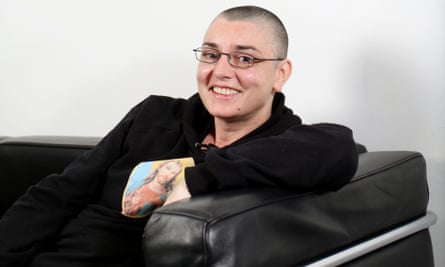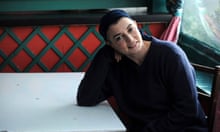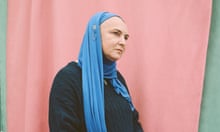By her own account, the childhood of the musician Sinéad O’Connor, who has died aged 56, was more than usually difficult: her parents split when she was young and, against her wishes, she was sent to live with her mother, who she said physically abused her and encouraged her to shoplift. The stealing led to the 14-year-old Sinéad spending 18 months at a training centre that had previously been one of Dublin’s notorious church-affiliated Magdalene laundries.
Although she was unhappy, O’Connor credited it with saving her life. It was there that she received her first guitar and a “punk-rock parka”, gifts from a sympathetic nun. This basic kit instilled the idea of music as a career; a decade later, O’Connor topped charts around the world with the single Nothing Compares 2 U.
The single’s video showed O’Connor – startlingly beautiful, hair cut to within half an inch of her head – crying real tears. The track was written by Prince, but O’Connor’s version, which displayed the clarity and expressiveness of her voice, became the definitive one, and was one of the biggest-selling singles of 1990. Its parent album, I Do Not Want What I Haven’t Got, sold 7m copies and was nominated for four Grammys. Commercially, it was the apex of a career that tormented rather than fulfilled her.
If the global superstardom conferred by Nothing Compares 2 U was brief – she lacked the obsessive drive needed to keep a top-flight pop career aloft – O’Connor nonetheless remained a household name for the rest of her life. Though unsought, the fame gave her a platform for expressing herself authentically in support of the causes she cared about: “Our job as artists is to be ourselves. And, in doing so, to inspire other people to be themselves.”
A passionate and highly engaged musician, she was one of her generation’s significant talents. Her bel canto-trained style and wide-ranging musical curiosity were her main assets, and she employed both prodigiously, switching from pop to Irish folk to jazz to reggae on the other nine albums she released. Nonetheless, it was her unswerving commitment to activism and truth-telling as she saw it that kept her in the headlines. “I didn’t want to be a pop star, I wanted to be a protest singer,” she said.
Outraged by Catholic church corruption, she campaigned for the arrest of paedophile church officials, while also using the platform of her fame to denounce sexism in the music business and an array of other issues. During a 1992 appearance on the US variety show Saturday Night Live, she tore up a picture of Pope John Paul II, inciting a storm of condemnation from America’s large Catholic population. At a Bob Dylan tribute gig in New York soon after, she was booed throughout her performance – even the endorsement of the songwriter Kris Kristofferson, who told her, “Don’t let the bastards get you down,” failed to silence the hecklers.
“Her name has become synonymous with courage and integrity,” Kristofferson said that night, but O’Connor never had another hit record in the US. Time proved her right about the church’s complicity in the abuse of children – in the early 1990s, however, she was perceived by many simply as an eccentric with an axe to grind. O’Connor could have appeased America by releasing another album in the vein of I Do Not Want What I Haven’t Got, but her next records were a jazz covers album, Am I Not Your Girl? (1992), and the grim Universal Mother (1994), which included a song about the 19th-century Irish famine and a track that had a beleaguered O’Connor pleading: “I’m fragile, I’m not no animal, though I am to you/ I’m not no crocodile like the one in Dublin Zoo.”
Her fervour was accompanied by an inability to edit her pronouncements: years before oversharing became the internet’s default mode, she regularly revealed troubling personal details about her mental health, relationships and family, causing one journalist to mock her as “the crazy woman in pop’s attic”, to which she took great exception. Oblivious to the usual dividing line between pop stars and the public, she sometimes appealed to fans for help in moments of emotional crisis, asking at various times for a spare room to live in, medical help for depression and a lawyer to resolve a child-custody dispute.
When seeking a new boyfriend, she invited overtures from male fans; the successful applicant, an Irish drug counsellor, Barry Herridge, became her fourth husband in 2011. If she thought it warranted, she also waded into other musicians’ business, finger-wagging. An open letter criticising Miley Cyrus for appearing naked in a 2013 video provoked a furious response from the younger singer, who said the video had been inspired by the emotional openness of Nothing Compares 2 U.

Born in the Dublin suburb of Glenageary, Sinéad was the third of five children. When her parents, Marie (nee O’Grady) and Sean O’Connor, a structural engineer turned barrister, separated, the eight-year-old and two siblings stayed with their mother. The abuse she allegedly endured led her father to seek custody, unsuccessfully, and inspired her 1994 song Fire on Babylon. Its first verse was “She took my father from my life/ Took my sister and brothers/ I watched her torturing my child/ Feeble I was then, but now I’m grown.”
After her time in the An Grianán training centre, she went to the liberal Newtown Quaker school. Marie O’Connor died in a car crash when Sinéad was 18, by which time she was singing in a band called Ton Ton Macoute and studying at the Dublin College of Music.
She signed to Ensign Records in 1985 and released her first album, The Lion and the Cobra, two years later. Its arrival saw her hailed as an important new singer-songwriter. The album cover alone – a shaved-bald O’Connor grimacing, fists raised – was markedly different from the female songwriter norm, and the stark, abrasive music experimented in a way that aligned her with Kate Bush and Björk. Five months before its release, she gave birth to her first child, Jake, whose father was John Reynolds, the drummer on the album. She and Reynolds married, and divorced in 1991 after four years.
Nothing Compares 2 U made her one of the highest-profile singers of the early 90s, but she was constitutionally unable to compromise her values. From the start she insisted on co-producing her records, and steered her own musical course with varying results. There were critical successes such as the warm, romantic How About I Be Me (and You Be You) (2012) and the dub-reggae influenced Faith and Courage (2000), but just as many perplexing curios, such as the Christian-rock Theology (2007) and a reggae covers record, Throw Down Your Arms (2005).
By the late 90s, she was more frequently in the news for personal reasons, such as her ordination as a priest called Mother Bernadette Mary by a breakaway Catholic sect in 1999, and the announcement that she was a lesbian, which she soon rescinded. In 2003 she was told she had bipolar disorder, but the diagnosis was later changed to post-traumatic stress disorder. She often seemed fragile, using social media to argue publicly with members of her family.
After Prince died in 2016, O’Connor – who had lost contact with the author of Nothing Compares 2 U many years before – claimed that his death was partly caused by hard drugs that were supplied to him “over the decades” by the American TV presenter Arsenio Hall. Countering that she was a “desperate attention-seeker”, Hall filed a defamation suit for $5m.
She converted to Islam in 2018, adopting the name Shuhada’ Sadaqat, which she used interchangeably with her birth name on social media. On her final concert tour, in 2019, she wore a hijab and abaya, but nothing else had changed – her voice still raised the hair on the back of the neck.
She was looking forward to releasing a new album, No Veteran Dies Alone, in 2021; a single, Trouble of the World, appeared, but the project was halted when she announced her retirement from music, though she quickly changed her mind about that decision. The album was scrapped altogether after her 17-year-old son Shane, from a relationship with the musician Donal Lunny, took his own life in 2022. “May he rest in peace and may no one follow his example,” she tweeted.
O’Connor’s second husband was a journalist, Nick Sommerlad, and the third the musician Steve Cooney. Each marriage ended in divorce. She is survived by her son Jake, a daughter, Róisín, from a relationship with the journalist John Waters, a son, Yeshua, from a relationship with Frank Bonadio, and a grandchild.
Sinéad Marie Bernadette O’Connor, or Shuhada’ Sadaqat, musician, born 8 December 1966; died 26 July 2023









